“If you change the future, you change the past.”
Totally makes sense, right? No? Well, welcome to the world of Final Fantasy XIII-2, where up is down, blue is red, and absolutely nothing makes sense.
After the release of Final Fantasy XIII in North America at the beginning of 2010, Square Enix was faced with the most impressive barrage of user complaints the gaming world has ever seen. FFXIII was too long, too linear, too hard, too easy, too Japanese, and brought nothing but shame to the Final Fantasy series. While the criticism was extremely harsh, as FFXIII was a very well made and entertaining entry to the series, Square Enix took it to heart and decided that the fans were right. One year later, Square Enix announced Final Fantasy XIII-2, the second direct sequel in the main Final Fantasy franchise. And thank god they did; Final Fantasy XIII-2 fixes almost every complaint gamers had with the original. However, as we all know, there’s always a catch.
Three years after the events of FFXIII, Lightning is a but a memory to most; believed to be dead by everyone except her own pink-haired sister, Serah Farron. She has assumed a new life on the surface of the lower world, Gran Pulse, as she awaits for her fiancé, Snow, to return with word of her sister’s whereabouts. Snow is beaten to the punch when a poorly dressed monster hunter named Noel Kriess falls through time to deliver a warning to Serah: Lightning is alive and Serah is the only one who can save her. The two then set out on a journey to not only save Lightning, but to fix a now broken timeline and save the world.
In an effort to address concerns of linearity, the game is comprised of nearly 30 areas of varying times and places. The two protagonists travel to these areas via gates connected to the Historia Crux, which acts as your central hub in-between the cracks of space-time. Originally presented as a single point in time, 3AF (three years after the fall of Cocoon, the main location of FFXIII), the Historia Crux continuously expands into a sprawling timeline with several branching paths, most of which culminate in either an alternate timeline or a secret “paradox ending” that players can unlock. On top of that, with special items, players can close gates, which reverses any decisions you’ve made in that specific area so you can replay them in a different way. A majority of the players time is spent hopping between these locations in an effort to resolve paradoxes caused by Lightning’s sudden disappearance.
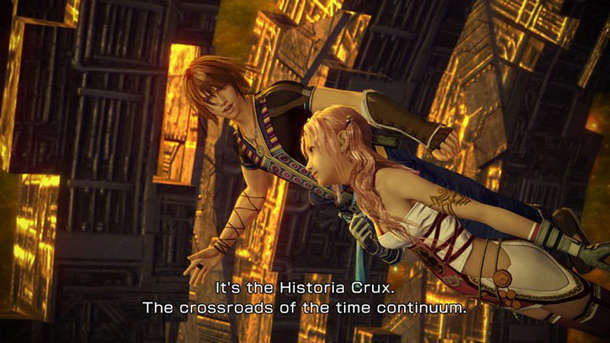
FFXIII-2 takes on a wibbly-wobbly perspective to time travel, meaning a lot of the time you’ll have to travel far into the future to change or obtain something so you can fix something in the past. Most of the time it doesn’t make sense, but effectively, you’re changing the future to change the past. Unfortunately, the lack of sense rings true for the story as well. Written like a “How to Time Travel for Dummies” self-help book, the plot is easy to dismiss as an overall mess. Gone are made up words like l’Cie and Fal’cie; they are now replaced instead by popular technobabble and sci-fi jargon that honestly makes little to no sense. Luckily, the voice acting is top-notch, with industry veterans Laura Bailey and Liam O’Brien lending their voices to Serah and brooding antagonist, Caius, respectively. While the earlier parts are very light on plot, the climax is extremely satisfying, especially when you’re presented with one of the darkest endings to a Final Fantasy title. Despite the rough opening, the ending more than makes up for any earlier misgivings.
While the story falters from time to time, the battle system stays strong throughout. Returning from FFXIII is the Active Time Battle variant, “Command Synergy Battle,” in which characters can freely change class roles mid battle to gain an edge against the enemy in what is called a “paradigm shift.” The best part of FFXIII-2‘s battle system is that it’s incredibly fast compared to the original. Instead of pausing gameplay to switch paradigms, characters now do it on the fly, often in the middle of attacking. This makes battle extremely fluid and ridiculously fast paced, which is most certainly a blessing for JRPG enthusiasts. This also means that players have to plan their moves several steps ahead, as they no longer have the grace period to revise their tactics.
Enemies no longer appear on screen; the game opts for a hybrid random/nonrandom encounter system. Essentially, enemies will appear randomly on screen. You have a certain grace period where you can either attack them or flee before they become agitated and turn their sights on you. Attacking them successfully will initiate a pre-emptive strike which bestows the speedy buff, haste, on the party, as well as filling the enemy’s stagger bar.
One of the main complaints against XIII was that you were only able to control one party member at a time and if that leader were to die, it would end the game. Now, in case of character death, the game will automatically switch to the next character, provided they are also alive. However, players can freely switch between the two both inside and outside of battle. In lieu of a full cast of party members, Serah has the unique ability to tame nearly every monster in the game. Over 100 monsters are at your disposable for a third party member, including a rainbow of chocobos and the dreaded tonberry.
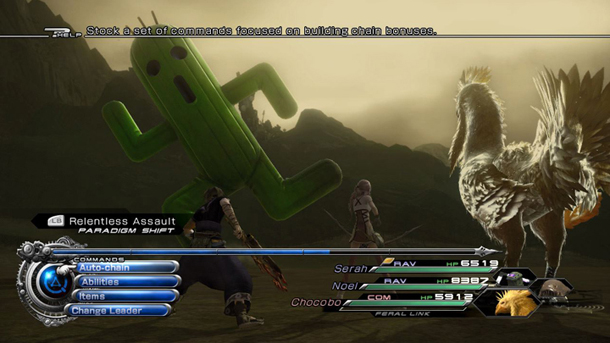
These monsters have special abilities called “feral links,” a small gauge that increases as you and your monster attack. Activating the feral link prompts the player with a limit break style combination of button presses. Performing well grants additional damage and benefits, depending on the feral link used. You have the ability to add up to three monsters to your party at a time, while the rest stay in your inventory as crystals. Unlike their human comrades, monsters are only given one role, but they can absorb other monsters in order to gain extra abilities.
Oddly enough, Square Enix decided to remove several abilities players had in XIII. Water spells are gone and haste can only be applied through pre-emptive strikes. Technique points, summons, and weapon upgrades are also missing from the game, however, none of these should be missed by fans of the original.
The crystarium, FFXIII‘s leveling system, was criticized for being too confined and linear, much like the rest of the game. The updated crystarium in FFXIII-2 is still fairly linear, but there is a lot more stat customization for interested parties. Made up to look like Serah and Noel’s weapons, players spend crystogen points on nodes to level up specific classes. Each node acts as a level, with nodes of various sizes bestowing specific stat boosts depending on class. Many people bemoaned the original crystarium in FFXIII for maxing out at level 5. Not one to disappoint, Square Enix boosted the level cap to 99 for every role, giving players 594 levels to grind through.
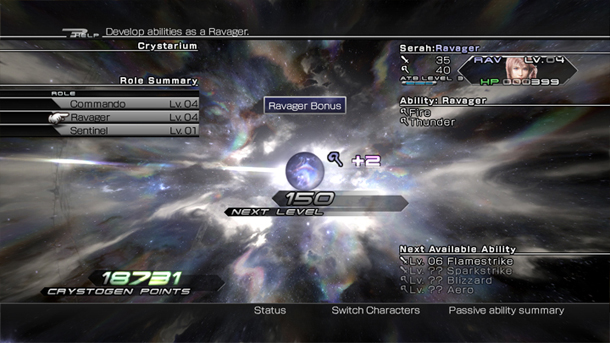
On top of this, Final Fantasy XIII-2 does away with save points altogether. Players are supplied near-infinite autosaves as well as manual saves that can only be accessed while in the Historia Crux. You also have the option of leaving an area at anytime, which the game saves that exact location in case you come back to it again. This makes starting and completing quests a delight, as you rarely have to worry about backtracking to the quest giver to complete an objective. This is a huge step forward for JRPGs, as it seems they have finally joined their western brethren by giving players the ability to save anywhere.
While Square Enix made many efforts to improve XIII through XIII-2, the short development time clearly lead to development cuts. The game is significantly less visually pleasing than the original, with muddy textures and canned animations all over the place. Granted, it still looks better than most games that have come out recently, but it lacks the precision and care used to make XIII’s animations more realistic. Serah’s original outfit is replaced by stereotypically skin-tight and barely-there “battle armor,” but players also have the option of buying downloadable outfits for her and Noel. Unfortunately, despite an “outfit” selection in the pause menu, there are no unlockable outfits included in the retail version.
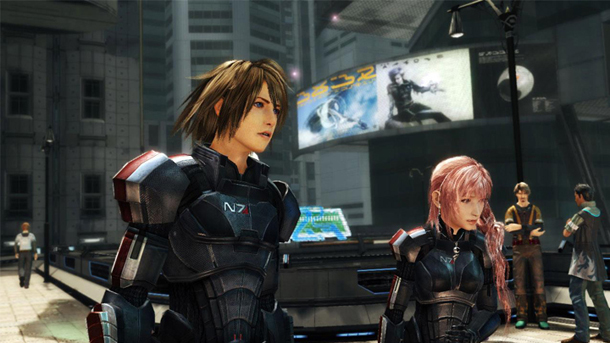
Also downloadable are coliseum battles, which pit players against the likes of the Omega Weapon and even Lightning herself. Each coliseum battle can be replayed in effort to recruit these characters to your party, although they will still be classified as monsters and given a specific role even if they’re human. Hopefully, Square Enix will continue to support the coliseum with more downloadable characters.
Overall, Final Fantasy XIII-2 is a great effort. It’s not often a company will listen to user complaints and try to fix them all in one go. While they didn’t hit the mark just right, their effort is something other developers should try and emulate when it comes to their own sequels. Square Enix has made great strides to bring the JRPG into modern relevance once again, and as such, should be supported by any fan for doing things right.

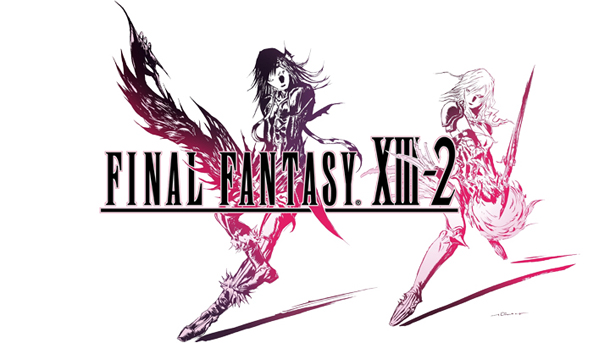

No Comments